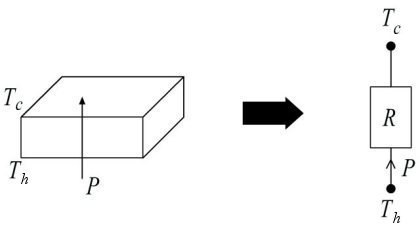www.leguman.ht.st
| HEAD LOSSES |
PUMPS |
CONDUCTION |
©
2001 - 2002.
|
| previous | ||
|
A little further... Let's look more closely at this formula; imagine that the lower surface of the plate is heated with a power P ( as could have been done with a cpu having the same surface area ), the temperature of the hot face is then:
Thus if Tc
is given ( to fix ideas one can take ambient air
temperature as a reference ); in order to have the lowest temperature
Th,
it is necessary to have the lowest thickness,
the largest surface area and the highest conductivity.
Some physical laws express phenomenon which have similar behavior, this is why an analogy with electricity is used : thermal resistance. It states a relation between the temperature difference ( electric voltage ) and the thermal power ( current intensity ), the Fourier's Law is the thermal equivalent of Ohm's Law :
Thermal resistance is measured in °C/W . That's a very significant data because it constitutes the only usable mean of measurement in practice and all heat exchanges will be expressed through this concept. Thermal resistance enables one to measure the effectiveness of a cooling system, this is the data at which it is necessary to look. Keep that in mind while waiting for the part on convection to know some more. Naturally, we are looking for the smallest possible thermal resistance in order to have the coldest temperature Th ( nearest to Tc in fact ). For the plate we see that
and we can make the equivalent electric diagram :
|
||
| previous |


